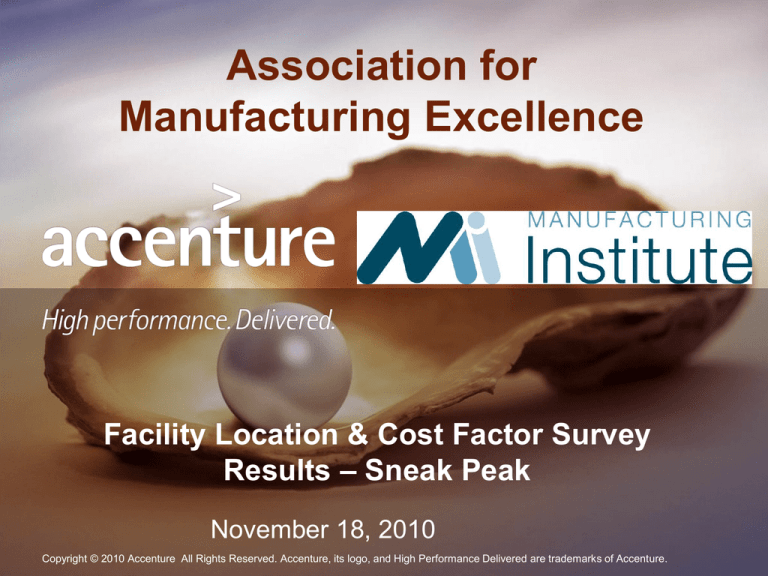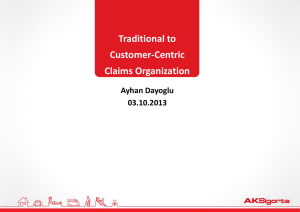
Association for
Manufacturing Excellence
Facility Location & Cost Factor Survey
Results – Sneak Peak
November 18, 2010
Copyright © 2010 Accenture All Rights Reserved. Accenture, its logo, and High Performance Delivered are trademarks of Accenture.
A total of 287 manufacturing executives (73% C-Suite, GM
and VP) participated in the survey
Demographics
Sample structure:
Industries (multiple select)
Local Headquarters
Consumer Products
49
Electrical / Electronic
Equipment
Industrial Goods
47
Pharmaceutical and
Medical
Automotive /
Transportation
Equipment
Aerospace / Defense
41
Food / Beverage
36
Machinery
35
Plastic, Rubber and
Composites
Metal Fabrication
30
Chemical / Process
24
Energy
46
37
United States
Job Title
258
18
Canada
6
Director
37
Asia
2
General Manager
13
Japan
2
Manager
32
Taiwan
1
Other:
55
$250 Million - $500 Million
43
20
$500 Million - $1 Billion
47
Telecommunications
17
$1 Billion - $5 Billion
62
BioTechnology / Life
Sciences
Paper, Wood, Printing
15
$5 Billion - $10 Billion
28
Greater than $10 Billion
52
Utilities Equipment
14
Software
Other:
107
9
Local Headquarters
Less than $250 Million
15
89
Europe
36
29
President or C-Level
Executive
Vice-President
8
19
Copyright © 2010 Accenture All Rights Reserved.
1
The most important factors in selecting locations for
manufacturing operations or supplier facilities are labor
costs, proximity to customers/market and skills of workforce.
What factors are the most important factors to you when selecting the
locations of your manufacturing operations or supplier facilities?
(Please select the 4 most important factors.)
Labor costs
74%
Proximity to the customer / market
67%
Skills of workforce
61%
Taxes
45%
Transportation costs
44%
Government regulations
37%
Other factors not specified:
(number of mentions =14)
Availability/quality of education
Export rules
Unique regional supplier capabilities
31%
Involved in Lean
Lead-time
Material Costs
Government incentives
24%
Ocean port
On the water
Currency exchange rates
Proximity to raw materials (2 mentions)
12%
Quality of Life
Other
Resources
5%
Total Delivered Cost
Unions
Source: Manufacturing Facility Location and Cost Factors Study, 2010
Copyright © 2010 Accenture All Rights Reserved.
Question 1
Where owner wants to live
Base=273
2
Direct costs are most often the only major components of an
organization’s total cost model used to evaluate production
and supplier location decisions
Issues
Which of the following are routinely considered part of your organization’s total
cost model that is used to evaluate production and supplier location decisions?
(Check all that apply)
Direct costs
Cost of Quality
Customer Service Costs
Region Specific Costs
Supply Chain costs
People/Talent
Costs
Financial
Operational costs
Logistics
Product unit cost / (supplier unit cost)
Product labor
Manufacturing overhead
Direct material / commodity
Packaging
Quality inspection / validation
Agility and speed of network supply
Customer responsiveness
Local taxes
Local regulations
Customs / duties
VAT taxes
Operational risk
Pipeline / network inventory
Safety stock
Broker fees
Export rules
Training
Organizational communication / coordination / management & control
Local operations staff (manufacturing, procurement, etc.)
Local incentives
Capital amortization
Terms
Exchange rates
Tooling / molds
In-network / In-plant material handling
Infrastructure (IT, Facilities)
67
66
64
64
57
28
39
48
38
48
39
35
20
39
26
21
7
1
32
30
29
29
26
25
23
23
16
36
Source: Manufacturing Facility Location and Cost Factors Study, 2010
Copyright © 2010 Accenture All Rights Reserved.
Question 2
Base=283
3
Material, component price and logistics, have by far had the
greatest percentage price increase over the last three years
Issues
Over the last 3 years, which of the following have had the greatest
percentage increase in costs for your products?
(Check up to 5)
Supplier material / component price
73%
Logistics and transportation
57%
Overhead & other administrative costs
36%
Exchange rate differentials
31%
Inventory (e.g., intra plant, supply chain, safety/buffer)
26%
Cost of quality
25%
Material handling & warehousing
18%
Packaging cost
16%
Country specific costs (e.g., VAT, customs, duties)
16%
Product qualification
16%
Supplier terms
13%
Customer service cost
13%
Increased procurement staff costs (e.g., broker fees, IT)
7%
Other factors not specified:
(number of mentions = 14)
Regulatory requirements (3 mentions)
3
Health Care Costs/Taxes (2 mentions)
2
Energy (2 mentions)
2
Commodity Price
1
Cost of money
1
Workers compensation Insurance
1
Government intervention taxes / bans
1
Insurance
1
Increased tooling costs
5%
Labor
1
Other
5%
Raw material
1
Source: Manufacturing Facility Location and Cost Factors Study, 2010
Copyright © 2010 Accenture All Rights Reserved.
Question 3
Base=273
4
Both near-shore and offshore operations have experienced
double-digit price increases over the last 12 months
Issues
What total price increase have you experienced from your suppliers or
manufacturing operations over the last 12 months (considering all of the
cost drivers identified in question 2)? __________% from Near-shore /
domestic and ______________% Off-shore
15,25
% on average
12,94
% on average
Note: Difference is not significant at 95%
confidence interval
Near-shore
/ domestic
Offshore
Source: Manufacturing Facility Location and Cost Factors Study, 2010
Copyright © 2010 Accenture All Rights Reserved.
Question 4
Base=287 (All) 5
Nearly half of the respondents have faced issues with
customer responsiveness and product quality from nondomestic manufacturing and supply facilities
Issues
From the following list, please select the five most important issues that you
have been facing from (non-domestic) manufacturing and supply facilities?
(Check up to 5)
Cycle / delivery time
Customer Service
49%
Responsiveness
Product customization
31%
11%
Cost to serve
15%
31%
Agility and speed of network supply
Flexibility / Agility
Supply Chain flexibility
30%
Flexibility
29%
Labor productivity
Operational & Supply
Chain
20%
Sales & Operations planning
Production efficiency
Process efficiency
19%
15%
9%
Exchange rate
Product Quality
Visibility
46%
Product quality
Product safety
11%
26%
Bottleneck in logistics networks
Visibility, coordination and control
22%
15%
Finding and retaining qualified people
People and Talent
Political and legal issues
Regional
14%
Culture and communication
Work council/Unions
Intellectual property theft
12%
10%
Source: Manufacturing Facility Location and Cost Factors Study, 2010
Copyright © 2010 Accenture All Rights Reserved.
Question 5
Base=276
6
More than half of companies are pursuing or planning to
pursue new supply options in the light of changing costs and
competitive issues
Actions
Which of the following actions has your organization taken or do you plan
to take with regard to your manufacturing / supplier base in light of
changing costs and competitive issues?
(Check all that apply)
Pursuing new supply options, whether near or abroad
59%
Improving within existing supply network
54%
Shifting the network to be better aligned with the customer
base / demand location
37%
Being more selective in making off-shoring decisions
34%
Pursuing new Low Cost County options
30%
Other factors not specified:
(number of mentions = 5)
Moving to greater concentration in one specific region region
regardless of customer base / demand location
N/A, we are leaving the existing network unchanged
Other
17%
5%
2%
Consolidation (2mentions)
Lean Suppliers - Quality and
Delivery
Looking into Tech
Optimization of the internal
supply network
Source: Manufacturing Facility Location and Cost Factors Study, 2010
Copyright © 2010 Accenture All Rights Reserved.
Question 8
Base=282
7
Production skills, work force availability and transportation
costs are the main barriers preventing companies from
rebalancing production
Barriers
What barriers will most likely impede your ability to rebalance production
and your supply base?
(Check all that apply)
Production skills, workforce availability
46%
Transportation Costs
45%
Supply base and supply base access
41%
Other factors not specified:
(number of mentions = 17)
Cash
Capital required
38%
Employment related issues (e.g., employment law, unionization)
31%
Local / Government content requirments
20%
Communication, overcoming
cultural differences
cost of energy
Export rules
Federal Government Taxes,
mandates and regulations
Not planning to rebalance
P&L expense
Government Incentives
18%
Political stability
Qualified suppliers
Resistance to change
Other Infrastructure related issues (e.g. legal protection)
14%
Local Taxes
13%
Supplier quality
Suppliers lacking desire to improve
current situation
Time
Top management mindset
Other
7%
US distributors
Utilities cost
Source: Manufacturing Facility Location and Cost Factors Study, 2010
Copyright © 2010 Accenture All Rights Reserved.
Question 10
Yet to be determined
Base=270
8
Companies recognize they need new capabilities to address
the rebalancing of their manufacturing and supply network
Needs
What capabilities do you believe your organization will need to address in
order to re-balance your manufacturing and supply network?
(Check all that apply)
Total cost analysis of options
61%
A comprehensive manufacturing and supply strategy
45%
Skills and knowledge of staff
44%
Ability to increase supplier capability and capacity
41%
Changing internal mindset to a longer-term, total cost view
34%
Other factors not specified:
(number of mentions = 6)
Improved understanding of local market capabilities
26%
N/A, I do not anticipate needing to rebalance production or supply
9%
Positive governmental support
Clear understanding of Government
Regulations
Lean Suppliers
Look for lower regulatory burdens
S&OP tools needed to forecast better
Other
2%
Timing of incurring expenses
Source: Manufacturing Facility Location and Cost Factors Study, 2010
Copyright © 2010 Accenture All Rights Reserved.
Question 9
Base=281
9
Over 60% of companies believe they need to undertake some
rebalancing of production or supply with demand
Actions
How well balanced do you believe your current manufacturing and supply
operations are with your current customer base / demand?
Very well balanced - we have
good responsiveness from
supply to demand needs
39%
We need to undertake some
rebalancing of production or
supply with demand
57%
We need to dramatically
change our network to better
balance supply with demand
61%
4%
Source: Manufacturing Facility Location and Cost Factors Study, 2010
Copyright © 2010 Accenture All Rights Reserved.
Question 6
Base=287 (All) 10
Companies will rebalance supply with demand
“Globally Local”
Direction
What is the approximate distribution (as a percentage of the total) of customers –
Supply Manufacturing by region today versus your projection for 3 years from now?
Customer vs. Supply Manufacturing Footprint Today
(Approximate %)
66,88 67,00
11,56
11,00
10,00
7,00
5,11
6,25
4,34
4,00
3,00
United States
/ Canada :
Mexico /
Central
America :
South
America :
Western
Europe :
3,00
Eastern
Europe /
Russia :
3,52 3,00
2,33 2,00
Middle East
/ Africa :
China :
Japan :
1,85
India :
Customer vs. Supply Manufacturing Footprint in Three Years
(Approximate %)
60,98
3,77
3,00
1,83
5,00
1,00
Australia :
Other Asia
/ Pacific :
Customer
Supply Manufacturing
62,00
13,00
10,97
9,00
8,00
6,50
8,51
6,00
5,37
4,11 4,00
4,00
3,78
3,42 3,00
2,00
United States
/ Canada :
Mexico /
Central
America :
South
America :
Western
Europe :
Eastern
Europe /
Russia :
Middle East
/ Africa :
China :
Japan :
2,97
4,00
India :
3,98
2,45 2,00
Australia :
Other Asia
/ Pacific :
Source: Manufacturing Facility Location and Cost Factors Study, 2010
Copyright © 2010 Accenture All Rights Reserved.
Question 13
Base=287 (All) 11
The percent change in some areas are allowing the balance
to “catch up” while in other areas
Actions
What is the approximate distribution (as a percentage of the total) of customers –
Supply Manufacturing by region today versus your projection for 3 years from now?
Customer vs. Supply Manufacturing Footprint
Change between Today and Three years
(Approximate %)
Customer
Supply Manufacturing
100%
62%
27%
14%
24%
33%
36%
33%
33%
South
America :
20%
0%
Western
Europe :
6%
0%
-3%
-5% -10%
Mexico /
Central
America :
34%
18%
3%
-9% -7%
United States
/ Canada :
61%
Eastern
Europe /
Russia :
Middle East
/ Africa :
China :
Japan :
India :
Australia :
Other Asia
/ Pacific :
Source: Manufacturing Facility Location and Cost Factors Study, 2010
Copyright © 2010 Accenture All Rights Reserved.
Question 13
Base=287 (All) 12
The main issues causing companies to re-balance their
manufacturing/supplier base strategy are costs, supplier
issues and governmental policies and regulations.
In light of changing policies and the economic environment, can you please describe what issues
may cause you to reevaluate or re-balance your manufacturing / supply base strategy?
Please Describe __________________
Main issues that may cause the re-evaluation or rebalancing of manufacturing /supply base strategy
Number of mentions
33
29
22
20
17
16
13
12
12
12
7
7
6
6
6
3
3
3
2
1
18%
16%
12%
11%
9%
9%
7%
6%
6%
6%
4%
4%
3%
3%
3%
2%
2%
2%
1%
1%
Costs i.e. increased costs
Supplier issues
Governmental policies and regulations
Low cost off shoring issues
Exchange rate
Customer demands in terms changing markets, locations,
relocations, expectations and sales volumes.
Supply and demand
Transportation costs
Current economic environment
Taxation
Health Care Costs
Labor costs
Capital
Inventory issues
Environmental issues
Competition
Profit Margin and market share
HR and training
Logistic costs
New product development
Source: Manufacturing Facility Location and Cost Factors Study, 2010
Copyright © 2010 Accenture All Rights Reserved.
Question 7
Base size = total sample
13
Cost issues, governmental policies, regulations and interventions, and
globalization are some of the greatest issues facing manufacturing
companies when considering balancing global manufacturing.
What do you believe are the biggest issues or concerns facing manufacturing companies today as
they think about balancing their global manufacturing and supply base?
56
26%
38
17%
34
16%
15
7%
(incl. aspects such as the rising costs of materials, transportation, labor,
shipping, importing and overheads. Remaining competitive, and balancing
cost domestically and offshore)
Cost issues
Governmental policies/regulations and
interventions
Globalization
(incl. aspect such governmental regulations that affect the manufacturing
industry in the US and changing regulations and policies that are not a
positive for the manufacturing industry in terms of cost implications and
import/export/taxes etc.)
Supplier base/supply chain
(incl. aspect such as supplier flexibility, continuity, reliability, supplier
development, quality, on-time delivery)
(incl. aspects such as labor force development, training. The availability of
skilled labor and the efficient hiring of skilled labor as well as the retainment
of the skilled workforce.)
17
8%
Skilled labor
15
7%
Quality of products
13
6%
Uncertainty in exchange rate/currency
fluctuation
11
5%
Demand vs. supply
(incl. are aspect of capacity to supply demand, lower demand in poor
economic conditions, reduced demand which will affect future demand,
forecasting, uncertainty and the need for increased demand)
8
4%
Investment capital
(incl. are aspect of availability of investment capital, and financing)
4
2%
Flexibility
(incl. are the need to be flexible in the changing economic climate and
changing markets)
3
1%
Communication
3
1%
The need for long term vision
(incl. are need to develop long term vision and policies and not only address
short term objectives)
1
1%
Inventory management
(incl. are the aspect of carrying too much inventory)
Copyright © 2010 Accenture All Rights Reserved.
Question 12
(incl. aspects such as the quality of both local and global products,
balancing quality and cost, capturing maximum cost reduction while
maintaining high quality)
14








